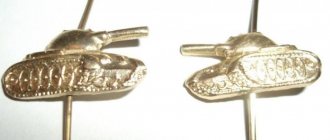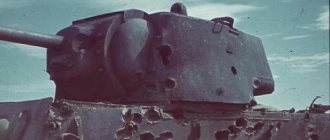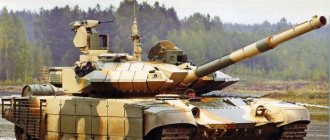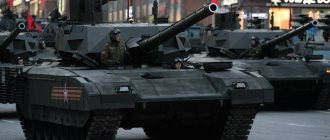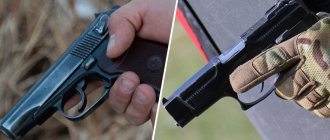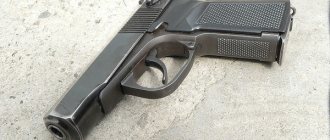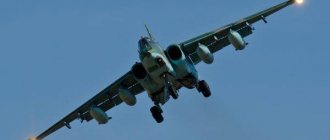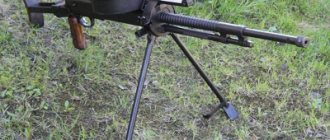Bridge layer MTU-90M – video
Experts consider the MTU-90M one of the most advanced tank bridge-layers to date; it has an easy-to-operate, well-developed and operationally reliable design of both the base machine and the bridge guidance system.
MTU-90M is designed for constructing in a combat situation a bridge crossing up to 19 m long across rivers, canals and water barriers, as well as ravines and engineering obstacles: ditches, scarps and counter-scarps, rubble. The machine ensures a high rate of crossing at any time of the day in any weather, as well as the assembly of a multi-span bridge crossing using bridges from the TMM-6 heavy mechanized bridge.
MTU-90M can be used in combat formations of the second echelon of tank regiments and the first echelons of tank divisions. The bridge is built without the crew leaving the vehicle. The fighting compartment is completely sealed and has protection against radioactive and chemical contamination of the area.
The bridge design uses a unique “triple scissors” design. The bridge is built using hydraulic drives. Removal of the bridge is possible from the opposite bank. Setting up and removing the bridge takes 2.0–2.5 minutes. The MTU-90M crew consists of two people, the maximum speed of the bridge layer is 60 km/h, over rough terrain - 20–25 km/h; Cruising range on the highway is 550 km.
Story
Interwar period
USSR
In the USSR, during the interwar period, a significant number of projects of engineering vehicles were developed based on tanks, which had all the main features of modern tank bridge layers, based on the T-18, T-26, T-27, T-28, BT-2 and BT-5 chassis. None of the projects went beyond the creation of prototypes and were not accepted for service[4].
The Second World War
Germany
In 1940, Nazi Germany created the Brückenleger IV bridge layer based on the PzKpfw IV medium tank. The vehicle was produced in a small series of 20 copies and did not have a significant impact on the course of hostilities[5].
UK and USA
During the Second World War, improvised vehicles became widespread in the Allied armies, created on the basis of the serial Churchill and Sherman tanks and similar in use to modern tank bridgelayers. The bridge structure was rigidly attached to the roof of the body of such a bridge layer, and to install it, the machine had to be located at the bottom of the obstacle, playing the role of an intermediate support.
Post-war period
The modern concept of tank bridge laying vehicles finally took shape in the 1950s-1960s, when the USSR created specially designed vehicles that entered large-scale production, and has remained without significant changes to the present day[2].
Performance characteristics of MTU-90
Crew, persons: 2 Years of production: 1999
Width of the obstacle to be overcome, m: 19 Load capacity of the bridge crossing, tf: 60 Time to install a place on the obstacle, min.: 2.5-3
Weight MTU-90
– 46.5 tons
Dimensions MTU-90
– Body length, mm: 6530 – Body width, mm: 3370 – Height, mm: 4500 – Ground clearance, mm: 492
Armor MTU-90
– Housing forehead, mm/deg.: 300
Engine MTU-90
– Engine type: V-92S2 – Engine power, l. s.: 1000
Speed MTU-90
– Speed on the highway, km/h: 60 – Speed on rough terrain, km/h: 20..25 – Cruising range on the highway, km: 650 – Climbability, degrees: 32 – Climbable wall, m: 0.85 – Overcoming ditch, m: 2.8 – Overcoming ford, m: 1.2..2.8
Notes
- ↑ 12
[military-encyclopedia.rf/Soviet-military-encyclopedia/M/Bridgelayer Bridgelayer] // Adaptive radio communication line - Object air defense / [under the general. ed. N.V. Ogarkova]. - M.: Military publishing house of the Ministry of Defense of the USSR, 1978. - P. 432. - (Soviet Military Encyclopedia: [in 8 volumes]; 1976-1980, vol. 5). - ↑ 12
Article II, paragraph 1 (I) // [www.osce.org/ru/library/14091 Treaty on Conventional Armed Forces in Europe]. - OSCE. - P. 5. - 124 p. - Compiled by: B. A. Kurkov, V. I. Murakhovsky, B. S. Safonov and others.
Tank bridge layer // Main battle tanks / Ed. B. S. Safonov, V. I. Murakhovsky. - M.: Publishing house. , with the participation of bargaining. houses "Rainbow" (Ukraine), 1993. - P. 173. - 191 p. — ISBN 5-85139-004-2. - Solyankin A. G., Pavlov M. V., Pavlov I. V., Zheltov I. G.
Domestic armored vehicles. XX century 1905-1941. - M.: Eksprint, 2002. - T. 1. - P. 219-220, 222-227, 248-249. — 344 p. — 2000 copies. — ISBN 5-94038-030-1. - [www.wwiivehicles.com/germany/tanks-medium/pzkpfw-iv-bruckenleger.asp Germany's Brückenleger IV] (English). wwiivehicles.com. Retrieved February 8, 2011. [www.webcitation.org/697dBlsQr Archived from the original on July 13, 2012].
An excerpt characterizing the Tank Bridge Layer
Bogucharovo was always, before Prince Andrei settled there, an estate behind the eyes, and the Bogucharovo men had a completely different character from the Lysogorsk men. They differed from them in their speech, clothing, and morals. They were called steppe. The old prince praised them for their tolerance at work when they came to help with cleaning in the Bald Mountains or digging ponds and ditches, but did not like them for their savagery. Prince Andrei's last stay in Bogucharovo, with its innovations - hospitals, schools and ease of rent - did not soften their morals, but, on the contrary, strengthened in them those character traits that the old prince called savagery. There were always some vague rumors going around between them, either about the enumeration of all of them as Cossacks, then about the new faith to which they would be converted, then about some royal sheets, then about the oath to Pavel Petrovich in 1797 (about which they said that back then the will came out, but the gentlemen took it away), then about Peter Feodorovich, who will reign in seven years, under whom everything will be free and it will be so simple that nothing will happen. Rumors about the war in Bonaparte and his invasion were combined for them with the same unclear ideas about the Antichrist, the end of the world and pure will. In the vicinity of Bogucharovo there were more and more large villages, state-owned and quitrent landowners. There were very few landowners living in this area; There were also very few servants and literate people, and in the life of the peasants of this area, those mysterious currents of Russian folk life, the causes and significance of which are inexplicable to contemporaries, were more noticeable and stronger than in others. One of these phenomena was the movement that appeared about twenty years ago between the peasants of this area to move to some warm rivers. Hundreds of peasants, including those from Bogucharov, suddenly began to sell their livestock and leave with their families somewhere to the southeast. Like birds flying somewhere across the seas, these people with their wives and children strove to the southeast, where none of them had been. They went up in caravans, bathed one by one, ran, and rode, and went there, to the warm rivers. Many were punished, exiled to Siberia, many died of cold and hunger along the way, many returned on their own, and the movement died down by itself just as it had begun without an obvious reason. But the underwater currents did not stop flowing in this people and were gathering for some new force, which was about to manifest itself just as strangely, unexpectedly and at the same time simply, naturally and strongly. Now, in 1812, for a person who lived close to the people, it was noticeable that these underwater jets were doing strong work and were close to manifestation. Alpatych, having arrived in Bogucharovo some time before the death of the old prince, noticed that there was unrest among the people and that, contrary to what was happening in the Bald Mountains strip on a sixty-verst radius, where all the peasants left (letting the Cossacks ruin their villages), in the steppe strip , in Bogucharovskaya, the peasants, as was heard, had relations with the French, received some papers that passed between them, and remained in place. He knew through the servants loyal to him that the other day the peasant Karp, who had a great influence on the world, was traveling with a government cart, returned with the news that the Cossacks were ruining the villages from which the inhabitants were leaving, but that the French were not touching them. He knew that yesterday another man had even brought from the village of Visloukhova - where the French were stationed - a paper from the French general, in which the residents were told that no harm would be done to them and that they would pay for everything that was taken from them if they stayed. To prove this, the man brought from Visloukhov one hundred rubles in banknotes (he did not know that they were counterfeit), given to him in advance for the hay. Finally, and most importantly, Alpatych knew that on the very day he ordered the headman to collect carts to take the princess’s train from Bogucharovo, there was a meeting in the village in the morning, at which it was supposed not to be taken out and to wait. Meanwhile, time was running out. The leader, on the day of the prince’s death, August 15, insisted to Princess Mary that she leave on the same day, as it was becoming dangerous. He said that after the 16th he is not responsible for anything. On the day of the prince’s death, he left in the evening, but promised to come to the funeral the next day. But the next day he could not come, since, according to the news he himself received, the French had unexpectedly moved, and he only managed to take his family and everything valuable from his estate.
Literature
- [military-encyclopedia.rf/Soviet-military-encyclopedia/M/Bridgelayer Bridgelayer] // Adaptive radio communication line - Object air defense / [under the general. ed. N.V. Ogarkova]. - M.: Military Publishing House of the Ministry of Defense of the USSR, 1978. - (Soviet Military Encyclopedia: [in 8 volumes]; 1976-1980, vol. 5).
- Article II, paragraph 1 (I) //
Airborne PVD-20 • DPP-40 Rear SP-19 • NARM • NZhM-56 • MLZh-M Means of motorization of crossings Towing and motor boats NKL-27 • SMK-75 • BMK-70 • BMK-90 • BMK-90M • BMK-130 • BMK-130M • BMK-130ML • BMK-150 • BMK-150M • BMK-150M1 • BMK-T • BMK- 225 • BMK-460 Motor links MZ-235 • MZ-330 Outboard motors SZ-10 • SZ-20 • MV-72 • MV-180 • SZM-45 Self-propelled landing craft Self-propelled ferries GSP • PMM • PMM-2 • PMM-2M • PDP Conveyors MAV • BAV • K-61 • PTS • PTS-M • PTS-2 • PTS-3 • PTS-4 Landing boats Iolshin's boat • Iolshin's bag • PMK • MIK-39 • A-3 • LG-12 • LMN • DSL • MSL • SDL • • MPK • DL-10 • NDL-10 • NDL-20 • NL-5 • NL-8 • NL-15 • NL-30 • SNL-8 Mechanized bridges Tank bridge layers MTU • MTU-20 • MT-55 • MTU-72 • MTU-90 Automobile bridge layers KMM • TMM • TMM-3 • TMM-3M • TMM-3M1 • TMM-6 Collapsible bridges Small spans MARM • TARM • MMP Medium and large spans SARM • BARM • TRM • MPB • GARM • RMM-4 • MVB Bridge construction means Combined arms KMS • KMS-E • USM • USM-2 • USM-3 Rear PSK-2-500 • SMP-86 • UZS • USB
Royal Engineers Tank Bridge in World War II
The unsuccessful raid on Dieppe by British and Canadian forces in 1942 confirmed that demolition and obstacle engineering efforts would be required for any large-scale invasion of continental Europe.
But they will have to be carried out “under armor.” Therefore, military engineers began work on new engineering vehicles with even greater enthusiasm. By the summer of 1944, the result of this work was the birth of three main assault bridges and a vehicle called the ARK, which were later used in the Normandy landings. Here, the main task of bridges was to organize crossings over such obstacles as narrow rivers, wetlands, ditches, canals, concrete walls (scarps), etc.
And now directly about the bridges.
30ft scissor bridge
Bridge No. 1 was a direct descendant of the earlier Scissor Assault Bridge and was designed to carry heavier loads (up to 20 t) over 30 ft (9 m) wide obstacles. Early prototypes used the Cruiser Tank Mark II (A10), but this was soon replaced by the new Cruiser Tank Mark V or Covenanter.
30ft Scissor Bridge, No. 1 on Covenanter Tank at Obstacle
30ft scissor bridge stacked on obstacle
Subsequent tests showed that the bridge was capable of carrying Class 30 loads (up to 25 tons), but the Covenanter was a poor design and was therefore replaced by the more successful Infantry Tank Mark III or Valentine.
Scissor bridge on the Valentine tank. AFV test site at Chobham, Surrey, 28 September 1943
Valentine" with Bridge No. 1 was used in Italy, Northwestern Europe and Burma.
There is information that several of these bridges were sent to the USSR under Lend-Lease. However, there is no specific data about this, although one copy of the “Valentine” with a scissor bridge is in the museum in Kubinka.
Tank bridge 30 feet
The Mark IV infantry tank, better known as the Churchill tank, posed a problem for Bridge No. 1. It was too heavy - 40 tons.
Therefore, a new bridge was designed in 1942. Bridge No. 2 still had to span a 30-foot gap, but instead of a Class 30, it was capable of carrying Class 60 tracked vehicles (up to 55 tons) and Class 40 wheeled vehicles (up to 42 tons).
"Churchill" with bridge No. 2
The load-carrying capacity of Bridge No. 1 could not be improved due to the peculiarities of its design, so a completely new approach was required.
And the solution was found: two arched steel tracks were connected by a set of cross braces and were driven by a hydraulic mechanism that kept the bridge horizontal throughout the entire process of lowering and raising.
The Churchill bridgelayer with Bridge No. 2 during a demonstration in the Mezzano area, March 30, 1945
The bridge was installed on a modified Churchill tank and was controlled by the driver, the other crew member was the commander, the entire process of placing the bridge on the obstacle took less than 2 minutes.
Bridgelayers based on the Churchill tank served in Italy and Northwestern Europe.
The bridge being built by Churchill across the river at Mergestel, October 26, 1944
Tank bridge with small box beam
The last of the three tank bridge layers was called the Tank Bridge Small Box Girder (tank bridge with a small box beam) or SBG Assault Bridge.
Designed specifically for D-Day and the 79th Armored Division, it was designed to support a Class 40 load (up to 36.6 tons) over a 30-foot (9 m) span, specifically a 12-foot sea wall. The bridge itself consisted of 4 sections connected together by cross beams to form a double track crossing.
In mass production, the bridge was called the Churchill Armored Vehicle Royal Engineers (armored vehicle of the Royal Engineers) or “Churchill” AVRE.
A cable and winch were attached to the engine deck, and an A-frame was attached to the front of the tank. The bridge was suspended from the front of the tank at an angle of about 60 degrees.
At the same time, the weight of the bridge hanging from the bow compressed the front suspension bogies and lifted the rear bogies from the ground. Thus, it was not easy to control the car when turning.
The bridge was lowered onto the obstacle using a winch.
There were attempts to move the bridge in other ways. These included folding the bridge in half (like a scissor bridge) and towing the bridge behind the tank while adding wheels to the bottom of the bridge.
The vehicle was not very popular among captains and helmsmen of landing ships, since the bridges “caught” the wind. Having them at the front of landing ships made it difficult to control the ship, so the bridges were often loaded as far on the deck as possible.
"Churchill" AVRE with a small box girder bridge
Unlike Bridges No. 1 and No. 2, the third bridge was carried by a standard armored vehicle (regular tank) rather than a specialized bridge vehicle.
This way the vehicle could be used in other roles after the bridge was detached.
It should also be noted that sometimes the axles were carried on a small trailer towed behind the tank and attached to the front of the tank immediately before use.
The sea wall bridge sequence is shown below, including the use of a fascine to break the fall.
Churchill AVRE assault vehicle in action. From the photo it is clear that the tank did not hit the fascine and landed unsuccessfullyThe photo below (in the red circle) shows the practical use of the AVRE Churchill Bridge to overcome a vertical obstacle.
Regarding the landing operation in Normandy, I would like to note the following.
In the month leading up to D-Day, the Allies conducted six exercises collectively called Exercise Fabius.
The last of the six exercises, in May 1944, was an exercise called Force J. This final full-scale dress rehearsal for the Normandy landings was so extensive that the night before the soldiers decided that they were actually heading for the French coast.
This is how William Brookes, general secretary of the East Wittering Local History Group, describes the event:
“A cold drizzle and dim gray light greeted the dim silhouettes of battleships, cruisers, transports and missile ships sailing towards the shore. The overburdened men began to climb the nets into their swinging assault craft below. The periphery of their vision was a detailed view of the invasion bay, brightly illuminated by flares and flashes of all shades and engulfed on the sides by dense clouds of smoke. They plunged into chest-deep waters while negotiating a labyrinth of coastal steel and wooden obstacles. Hot on the heels of an advancing platoon of tanks, the men of the North Shore (New Brunswick) Regiment raced toward their first objective: building a local farmhouse. With a sudden force, the front door to the property swung open and behind it, to the bewilderment of the invaders, appeared Mr. Ray Balchin, owner of Culimores Farm. As he watched his beloved hedges being torn to pieces by the mechanized onslaught of the marvelous machines, Mr. Balchin decided he could no longer stand by. A torrent of profanity rained down on the stunned soldiers like the proverbial machine-gun fire. After several seconds of silent amazement, one infantryman replied: “Sir... You are English!” Yes, these weren't actually the beaches of Normandy. It was Bracklesham in West Sussex."
Training on the use of the Churchill Bridge AVRE before landing on the Normandy coast
ARK armored personnel carrier
The need for new tank bridgelayers, as indicated above, was more clearly defined after the unsuccessful amphibious landing at Dieppe.
This equipment was supposed to help ensure the advance of tanks and other armored vehicles in difficult terrain. A number of new engineering armored vehicles were soon developed, including several variants of the Churchill ARK (Armored Ramp Carrier) tank-bridge.
The ARK was used to overcome small obstacles and was a tank with the turret removed and ramps mounted on the top of the superstructure and on both ends of the hull.
A vehicle was driven into an obstacle, ramps were deployed, and other vehicles simply drove through it.
The ARK Mark I was used on D-Day primarily for breaching sea walls and defense. It had a 2 foot wide wooden walkway with short ramps. By opening the ramps, the machine created a track bridge up to 10 m long and 3.3 m wide.
In February 1944, serial production of bridge layers began. In total, about 50 bridges were made.
ARK Mk I helps a Sherman tank climb an obstacle. Tests, February 13, 1944
After the July 1944 battles in France, the Mk I model underwent significant modernization. The new version of the vehicle was designated ARK Mk II.
ARK Mk II featured a different section design. First of all, the length of the outer ramps was increased, and the width of the left ramps of the bridge was also doubled (see photo below), which made it possible to drive across the bridge not only tanks, but also vehicles with a smaller track.
The new vehicle made it possible to organize a crossing 12–15 m long versus 10 m on the Mk I.
In the transport position, the ramps were raised up and attached at an angle to special masts with cables. To move the bridge into a combat position, the fastening locks on the cables were opened, and the ramps fell to the ground under their own weight. After completing the combat mission, the bridge layer needed the help of another vehicle capable of raising the ramps to the transport position.
Tank bridge "Churchill" Ark Mk II
In the same 1944, a version of the bridge called the Great Eastern Tank Ramp was developed on the basis of the Churchill. It was equipped with two ramps: one 8.2 m long, the other 7.6 m long. This was supposed to help overcome higher obstacles than conventional ARKs could force.
In 1945, 10 vehicles were built, but they never saw service in the war.
Great Eastern Tank Ramp Bridge during testing
In April 1945, the ARK assault bridge was deployed on the Sherman tank and was named the Sherman Twaby ARK.
This was the last of the assault bridge designs developed during the war.
Two track sections were installed on the roof of the hull, and folding ramps were installed in front and behind. The bridge spanned an obstacle up to 15 m wide or up to 4.5 m high. In the stowed position, the ramps were held using central racks of the Churchill Ark Mk II type. In this case, the rear ramps were laid horizontally above the central track sections, and the front ones were installed at an angle.
Like the previous version, these bridges were also late for the war.
Sherman Twaby Ark bridge vehicle with ramps in stowed position, April 4, 1945.
Sherman Twaby ARK bridgelayer in working deployment
To conclude, here’s a short video about special vehicles developed for the Day of D-Day in Normandy.
The ending follows...
